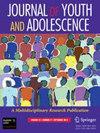Risking for Good: A Three-Wave Within-Person Analysis of the Reciprocal Relations Among Prosocial Risk Taking, Positive Risk Taking, and Prosocial Leadership.
IF 3.6
1区 心理学
Q1 PSYCHOLOGY, DEVELOPMENTAL
引用次数: 0
Abstract
Adolescence is a developmental stage characterized by increased engagement in risk taking, which can serve adaptive functions such as identity exploration and social integration. However, most existing research has focused on negative risk taking, with limited attention to how positive and prosocial risk taking contribute to adolescents' leadership development. Moreover, previous studies on adolescent risk taking have predominantly relied on cross-sectional designs, leaving within-person developmental processes underexplored. This study utilized three-wave longitudinal data (N = 554; mean age = 13.35 years, SD = 0.35 years; 50% girls) to examine the relations among positive risk taking, prosocial risk taking, and prosocial leadership. Participants were assessed at three time points: July 2020 (T1), January 2021 (T2), and July 2021 (T3), each wave separated by six months. The Random Intercept Cross-Lagged Panel Model (RI-CLPM) was applied to distinguish within-person effects from between-person effects. Results indicated that, at the within-person level, both positive risk taking and prosocial risk taking predicted subsequent increases in prosocial leadership, which in turn, predicted further increases in positive and prosocial risk taking. Conversely, negative risk taking was not significantly associated with prosocial leadership at the within-person level. These findings suggest that participation in positive and prosocial risk-taking activities facilitates the cultivation and reinforcement of leadership skills among adolescents.为善而冒险:亲社会风险承担、积极风险承担和亲社会领导相互关系的三波分析。
青春期是一个发展阶段,其特点是更多地参与冒险,这可以为身份探索和社会融合等适应功能提供服务。然而,现有的研究大多集中在消极的冒险行为上,很少关注积极的和亲社会的冒险行为对青少年领导力发展的影响。此外,先前关于青少年冒险行为的研究主要依赖于横断面设计,而对个人发展过程的探索不足。本研究采用三波纵向数据(N = 554,平均年龄= 13.35岁,SD = 0.35岁,50%为女生)检验积极冒险、亲社会冒险与亲社会领导之间的关系。参与者在三个时间点进行评估:2020年7月(T1), 2021年1月(T2)和2021年7月(T3),每一波间隔6个月。随机截距交叉滞后面板模型(RI-CLPM)被用于区分人内效应和人间效应。结果表明,在人内水平上,积极的冒险行为和亲社会的冒险行为都预测了随后亲社会领导行为的增加,而亲社会领导行为反过来又预测了积极的和亲社会的冒险行为的进一步增加。相反,负风险承担与亲社会领导在个人层面上没有显著相关。这些发现表明,参与积极和亲社会的冒险活动有助于培养和加强青少年的领导技能。
本文章由计算机程序翻译,如有差异,请以英文原文为准。
求助全文
约1分钟内获得全文
求助全文
来源期刊

Journal of Youth and Adolescence
PSYCHOLOGY, DEVELOPMENTAL-
CiteScore
8.20
自引率
6.10%
发文量
155
期刊介绍:
Journal of Youth and Adolescence provides a single, high-level medium of communication for psychologists, psychiatrists, biologists, criminologists, educators, and researchers in many other allied disciplines who address the subject of youth and adolescence. The journal publishes quantitative analyses, theoretical papers, and comprehensive review articles. The journal especially welcomes empirically rigorous papers that take policy implications seriously. Research need not have been designed to address policy needs, but manuscripts must address implications for the manner society formally (e.g., through laws, policies or regulations) or informally (e.g., through parents, peers, and social institutions) responds to the period of youth and adolescence.
 求助内容:
求助内容: 应助结果提醒方式:
应助结果提醒方式:


